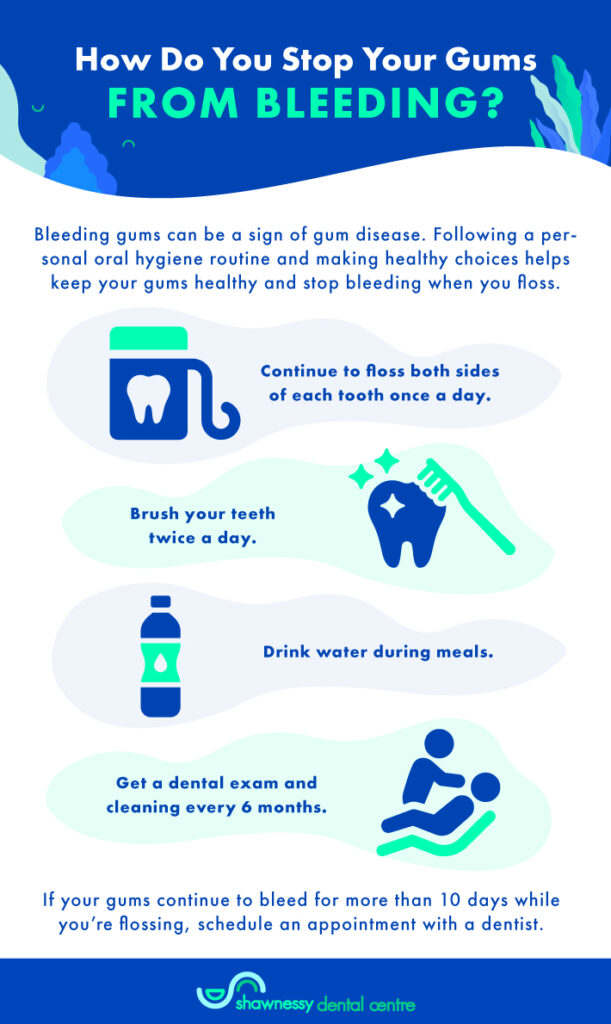How often do you floss? That’s one of the questions a dentist might ask during a dental exam if we notice your gums are bleeding. Unfortunately, if your gums bleed when you floss, you might be less inclined to try again—but in many cases, you should.
Your gums may bleed when you floss if you:
- Just started again flossing after not flossing for a long time
- Are not using a proper flossing technique
- Have a vitamin C deficiency
- Are taking new blood-thinning medications
- Have inflamed gums from gingivitis or periodontitis
Learning what causes your gums to bleed and why flossing is important can decrease the mental roadblocks to flossing. You can take steps to support your oral health and avoid the need for restorative dentistry like fillings or root canals with a complete oral hygiene routine.
How Can You Keep Your Gums Healthy?
If you’ve just started flossing again after not flossing for a long time, and you notice your gums bleed after, keep an eye on them, but don’t stop flossing.
Keeping your gums healthy starts with preventing gum disease, including flossing regularly. When you stop flossing, plaque builds up, and your gums may become inflamed, so they bleed.
Bleeding gums often indicate gum disease and inflammation from plaque and tartar buildup. When plaque forms in your mouth, it can hide in hard-to-reach areas between your teeth. When plaque isn’t removed, it can harden, turn into tartar, and lead to periodontitis—also known as gum disease.
During its early stages, gum disease is known as gingivitis—and gingivitis can be reversed with a complete oral care routine and healthy lifestyle habits.
Follow a Healthy Dental Hygiene Routine
Your personal dental care routine should include:
- Brushing twice a day
- Flossing once a day
Simple, right? Brushing and flossing are the foundation of a personal routine that supports healthy gums and prevents gum disease.
You can also use mouthwash to remove bacteria from other hard-to-reach areas. We can recommend mouthwash based on your lifestyle and dental needs during your next dental exam.
Practice Healthy Lifestyle Habits
How often do you drink pop or other sugary drinks? What foods do you choose to support your dental health? How much water do you drink in a day? Answering all these questions can pave the way toward lifestyle habits that help prevent bleeding gums and gum disease.
Some of the healthy habits we recommend include:
- Making water your drink of choice: Avoid acidic and sugary drinks.
- Eating foods that teeth love: Plain milk, fruit, raw vegetables, plain yogurt, cheese, hard-boiled eggs, nuts, and salads are all foods recommended by the Canadian Dental Association.
- Drinking plenty of water during meals: Drinking water while you eat helps wash away food particles that might otherwise get stuck between your teeth and turn into plaque.
Get Regular Dental Exams & Cleanings
We recommend having a dental exam and cleaning every 6 months.
Flossing and brushing your teeth are a good start, but they might not eliminate all the particles in your mouth. Even a small amount of food particles can become plaque and harden into tartar, leaving you with unknown issues that can become bigger problems.
Tartar can’t be removed with brushing or flossing alone. When you visit us for a dental exam, we use scaling and root planing to remove stubborn plaque and tartar from areas you might miss when brushing or areas that can be hard to clean—such as below your gumline.
What Is the Correct Way to Floss?
Improper flossing techniques can also irritate your gums and cause bleeding, but when you don’t floss, you could be missing more than one-third of your tooth’s surface. So, learning the right way to floss and practicing each day are crucial for cleaning your teeth at home.
Follow these steps to floss your teeth:
- Use a length of floss equal to the distance from your hand to your shoulder.
- Wrap the floss around your index fingers, leaving about 5 centimetres (2 inches) of floss between your fingers.
- Slide the floss between your teeth and wrap it into a “C” shape around the base of your tooth.
- Gently move the floss and wipe from the base to the tip of your tooth 2–3 times.
- Floss both sides of each tooth, including the backs of your molars. Use a new section of floss as the section you’re using wears out.
- Brush your teeth after flossing.

How Do You Treat Bleeding Gums?
If your gums bleed because of gingivitis, you may need to continue flossing and brushing your teeth to stop the bleeding.
If you’re a regular flosser already or the bleeding doesn’t stop after 10 days, you should visit a dentist for a dental exam—in-office treatments and dental care may be needed to address issues that cause persistent bleeding.
Reversing Gingivitis
In some cases, you may be able to stop your gums from bleeding by reversing gingivitis. The key to reversing gingivitis is getting rid of all the plaque on your teeth and stopping plaque from building up again.
Regular brushing, flossing, and dental checkups are often all that’s needed to reverse gingivitis, but you may also need more frequent teeth cleanings to monitor your oral health. In some cases, a dentist may prescribe a rinse to help kill bacteria in hard-to-reach areas, too.
Treating Periodontitis
When gingivitis becomes periodontitis (an advanced form of gum disease), it can threaten your overall oral health and well-being.
Periodontitis can lead to tooth loss and bone loss in your jaw, increasing the potential you may need crowns and bridges while reducing the potential for dental implants as a suitable form of treatment.
Periodontitis can be treated with scaling and root planing. Your dentist may also prescribe a rinse and more frequent dental visits to prevent periodontitis in the future.

When Should You Talk to a Dentist About Bleeding Gums?
If you are a regular flosser and experience bleeding gums or your gums continue to bleed 10 days after you start flossing again, you should schedule an appointment with a dentist.
With a thorough exam and cleaning, we can evaluate your teeth and gum health, determine what may be causing the bleeding, and provide guidance for treatments and next steps. Book an appointment today to speak to our Shawnessy Dental Centre team about your oral health.



